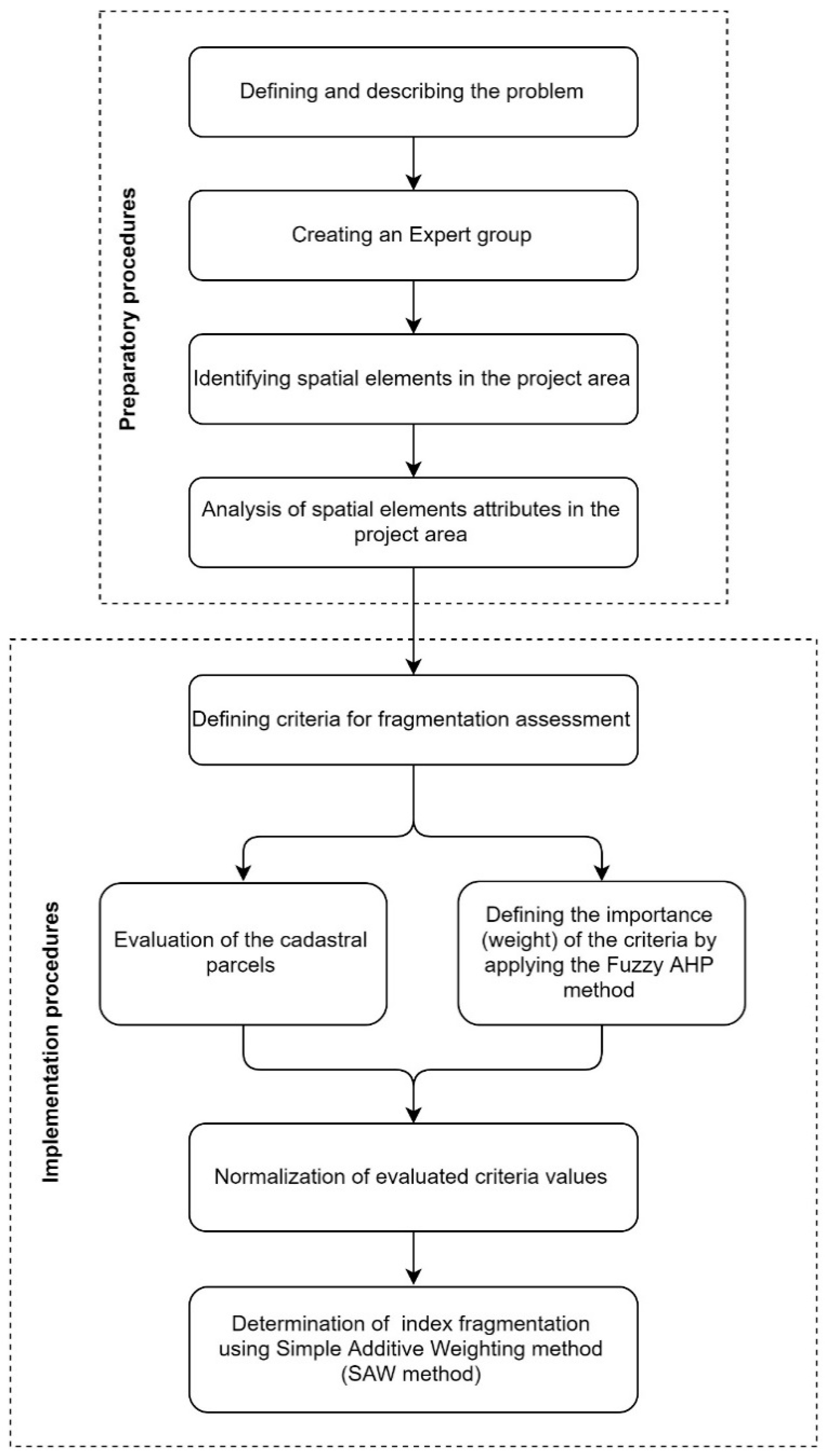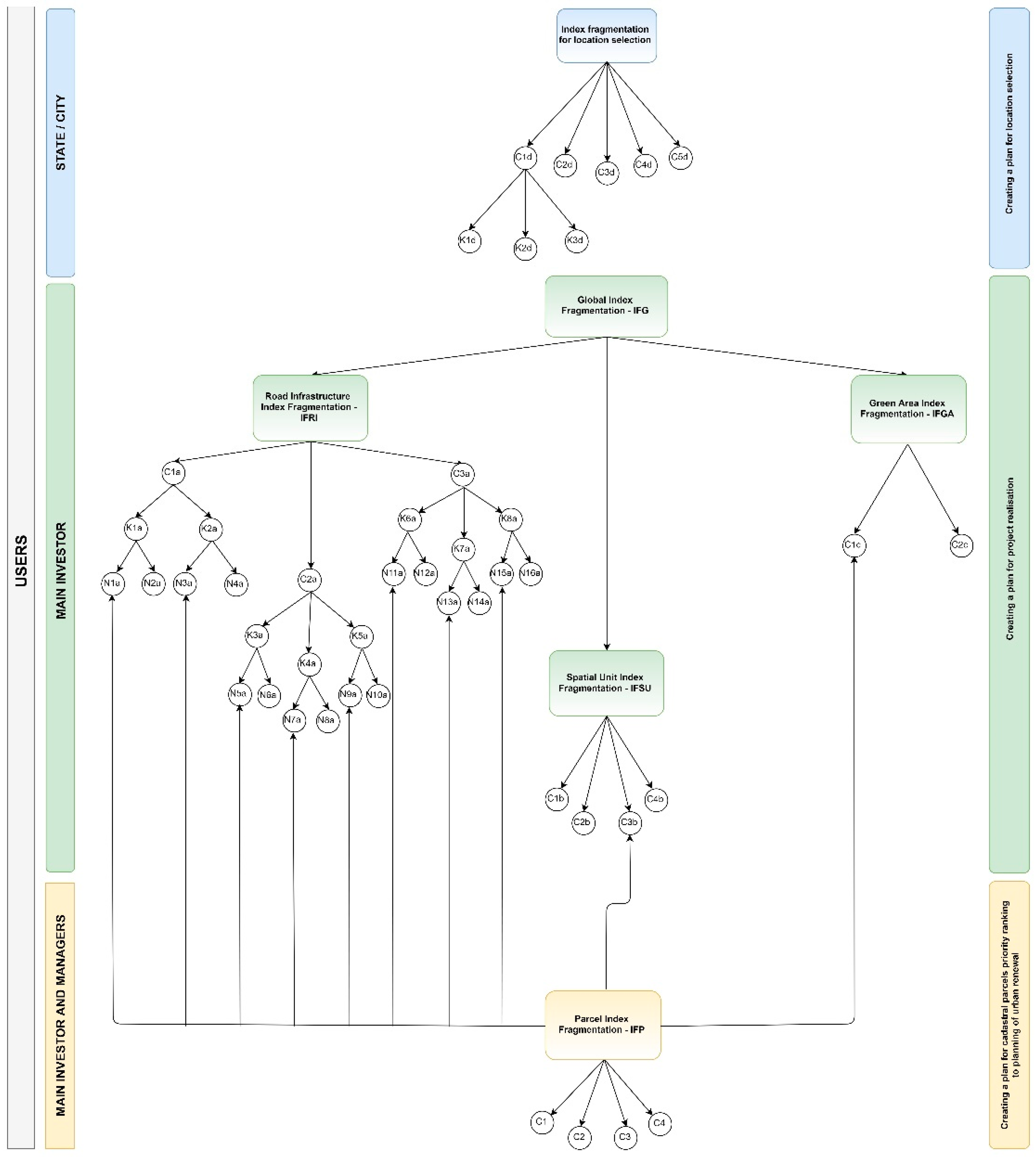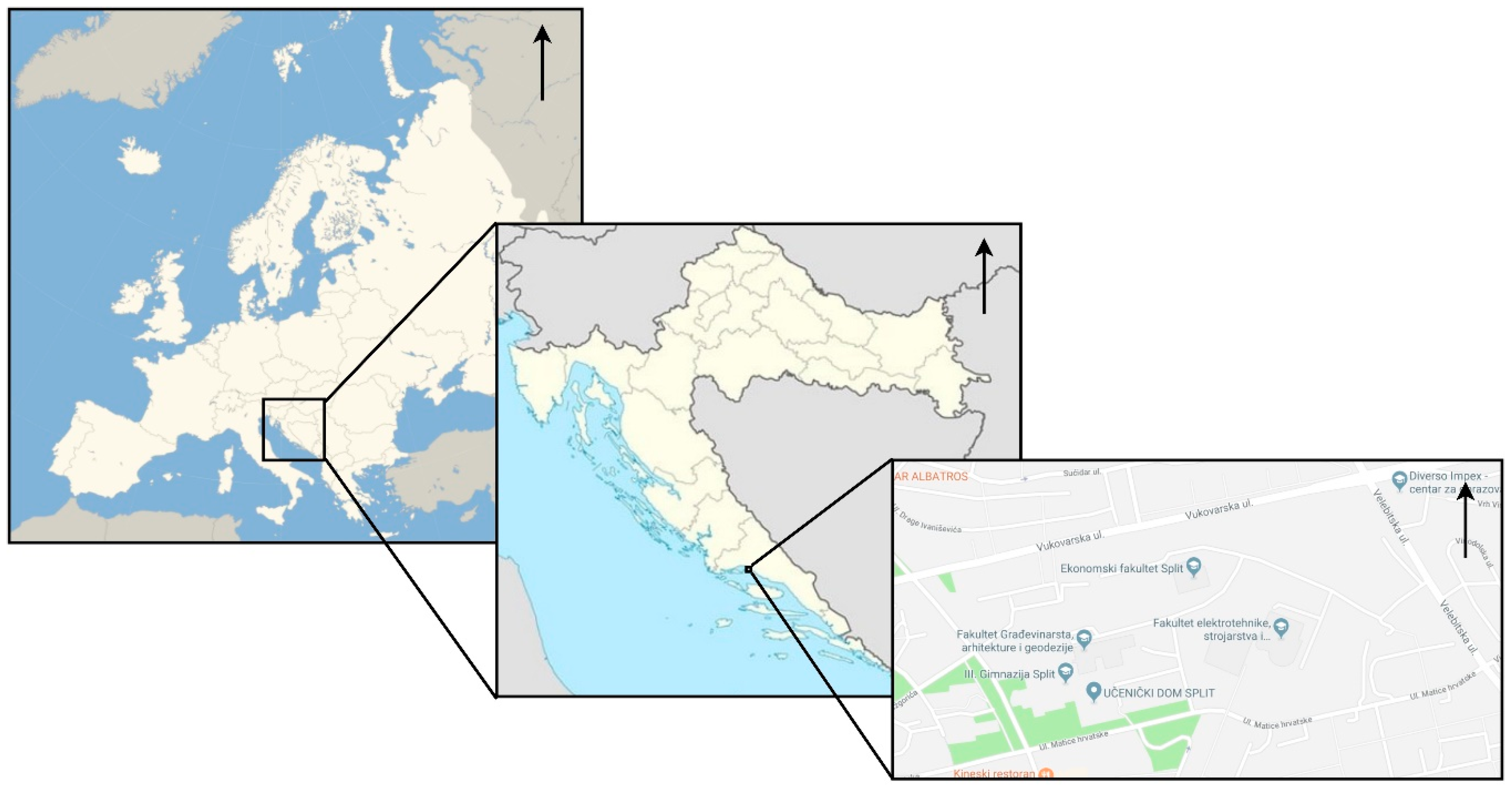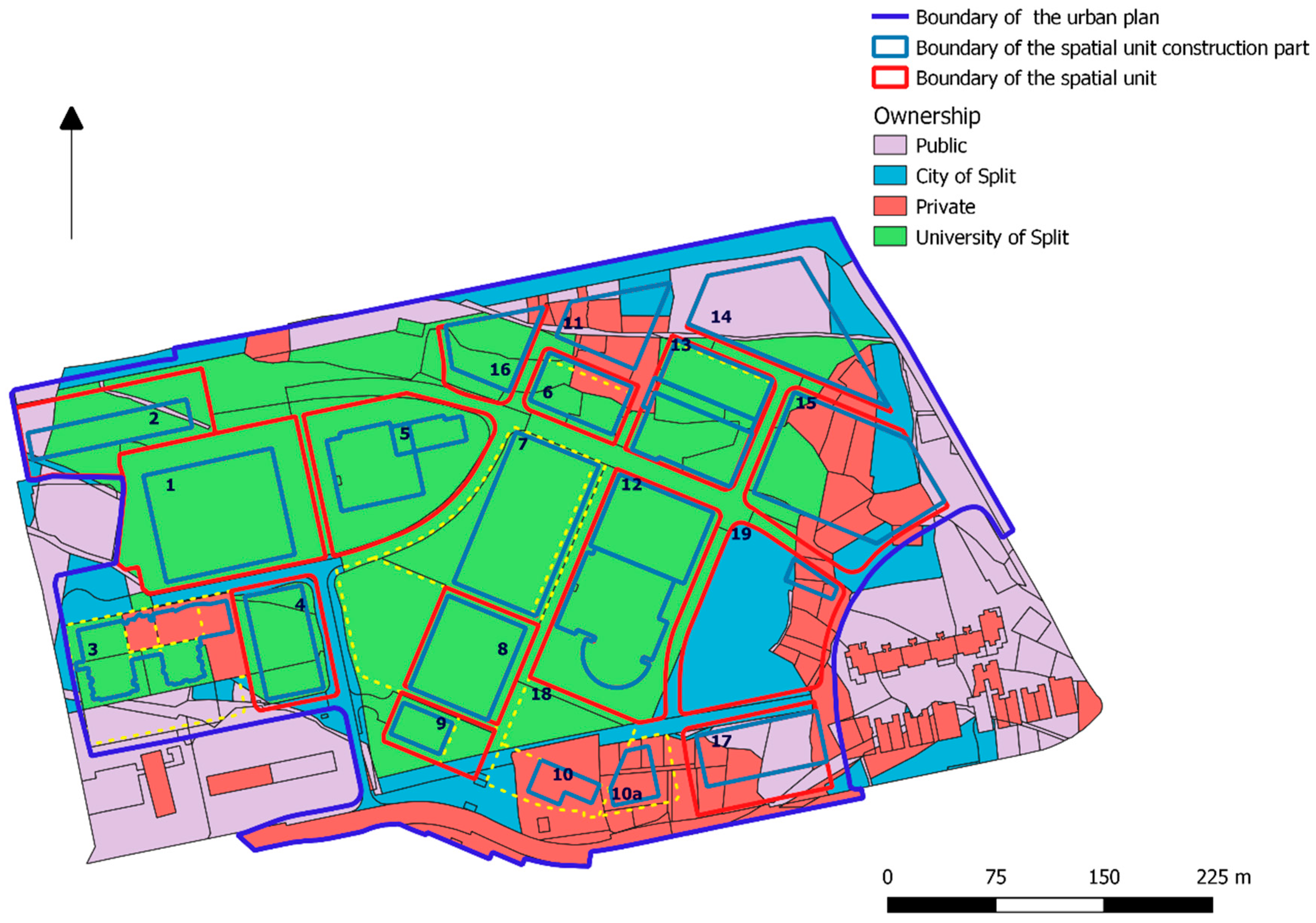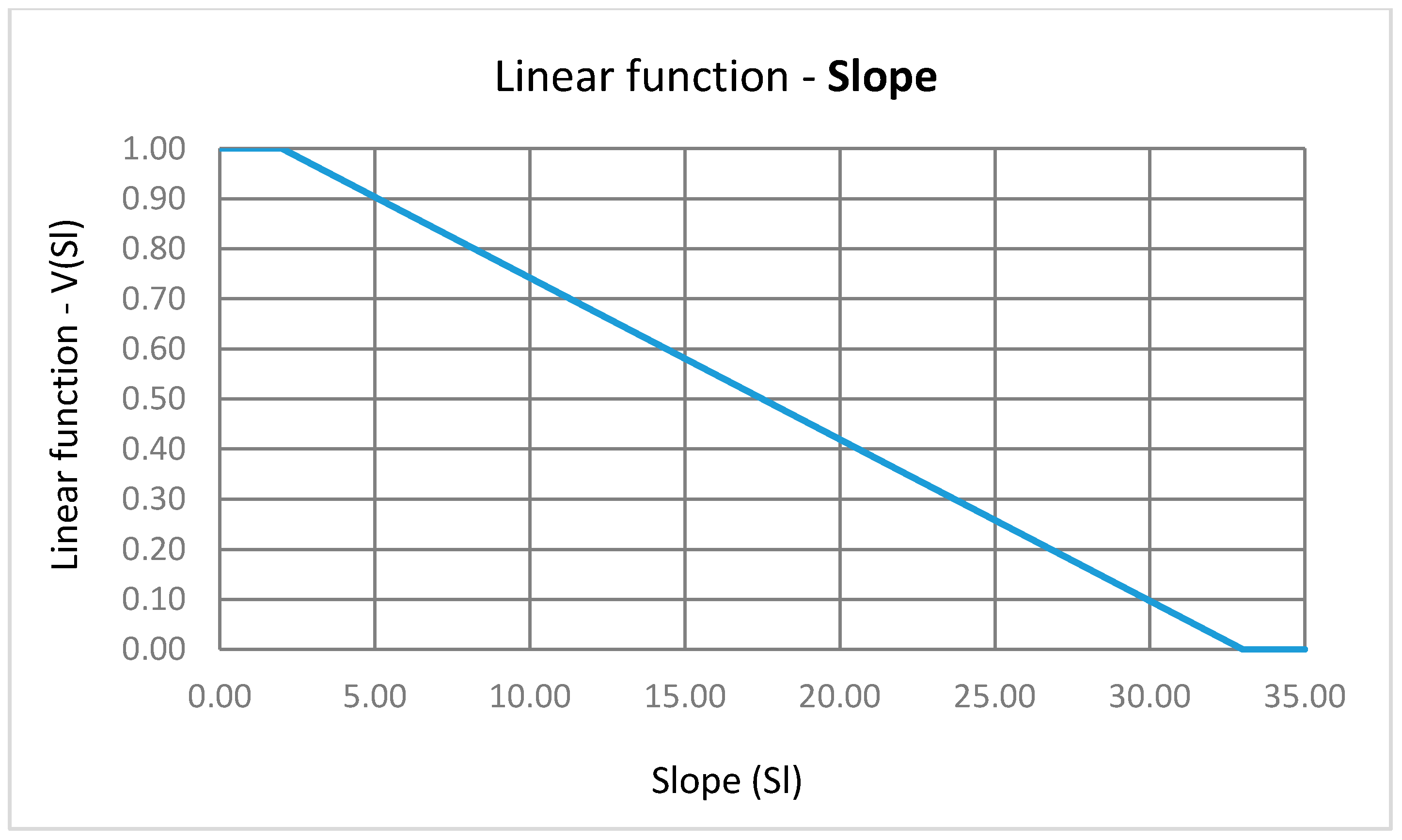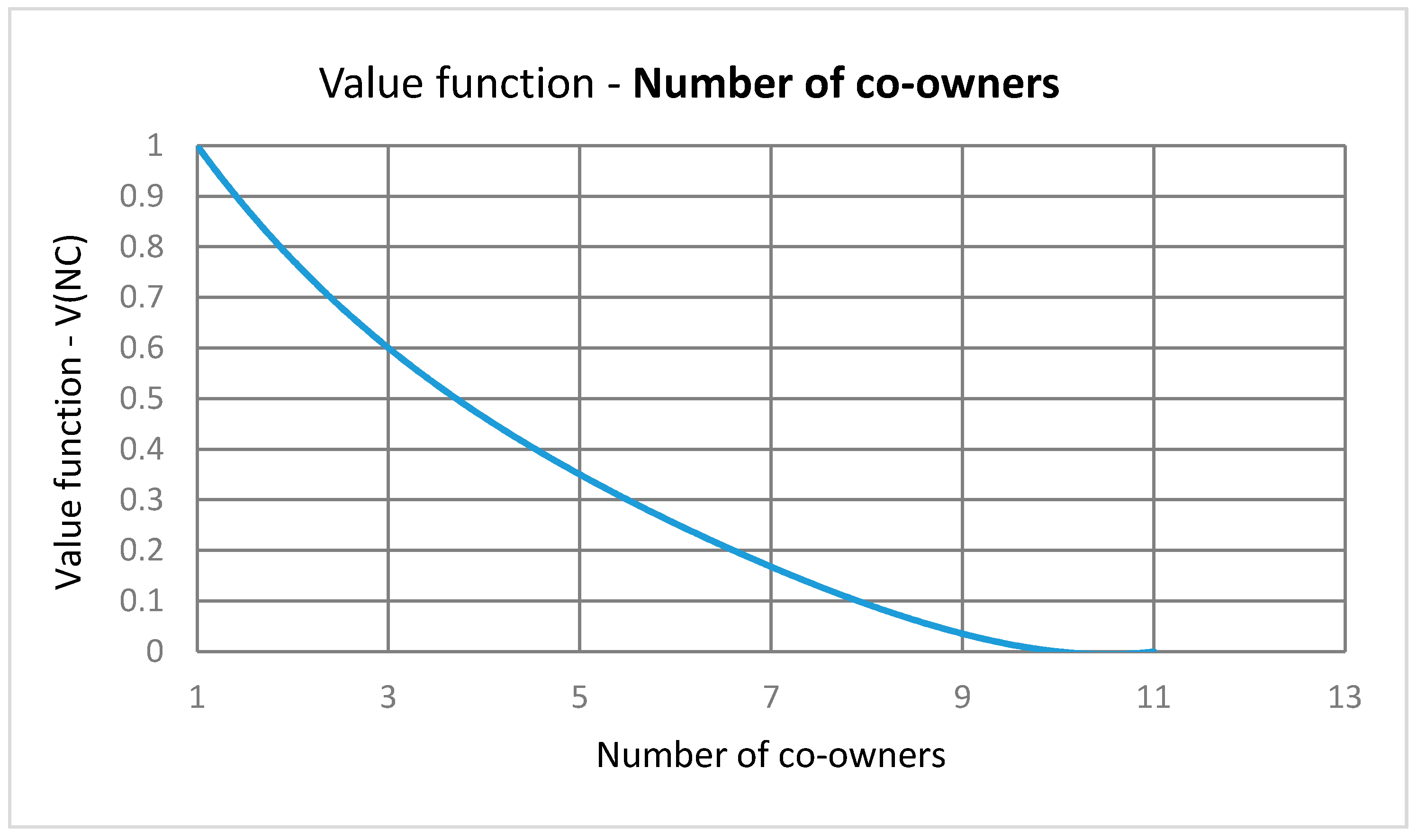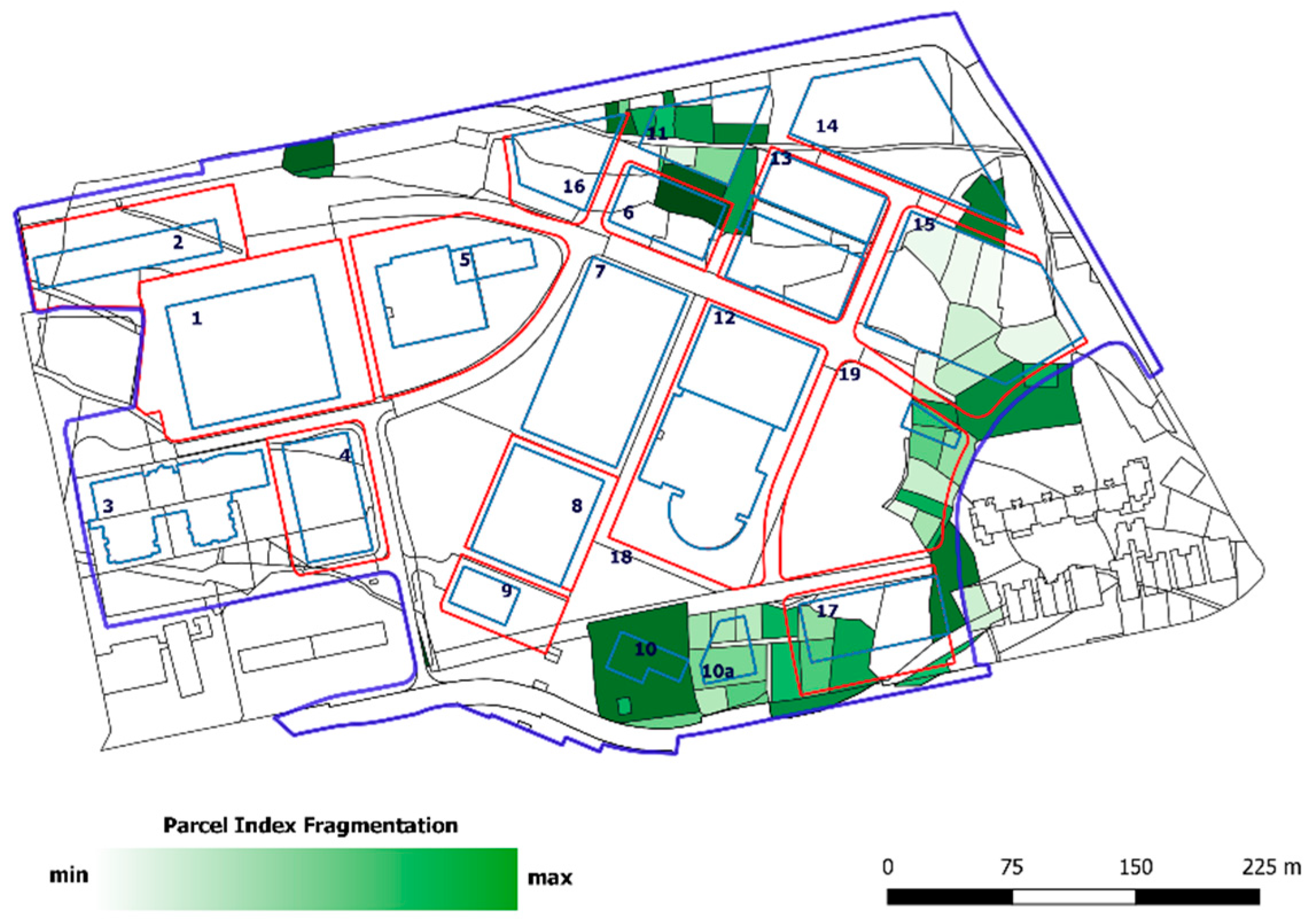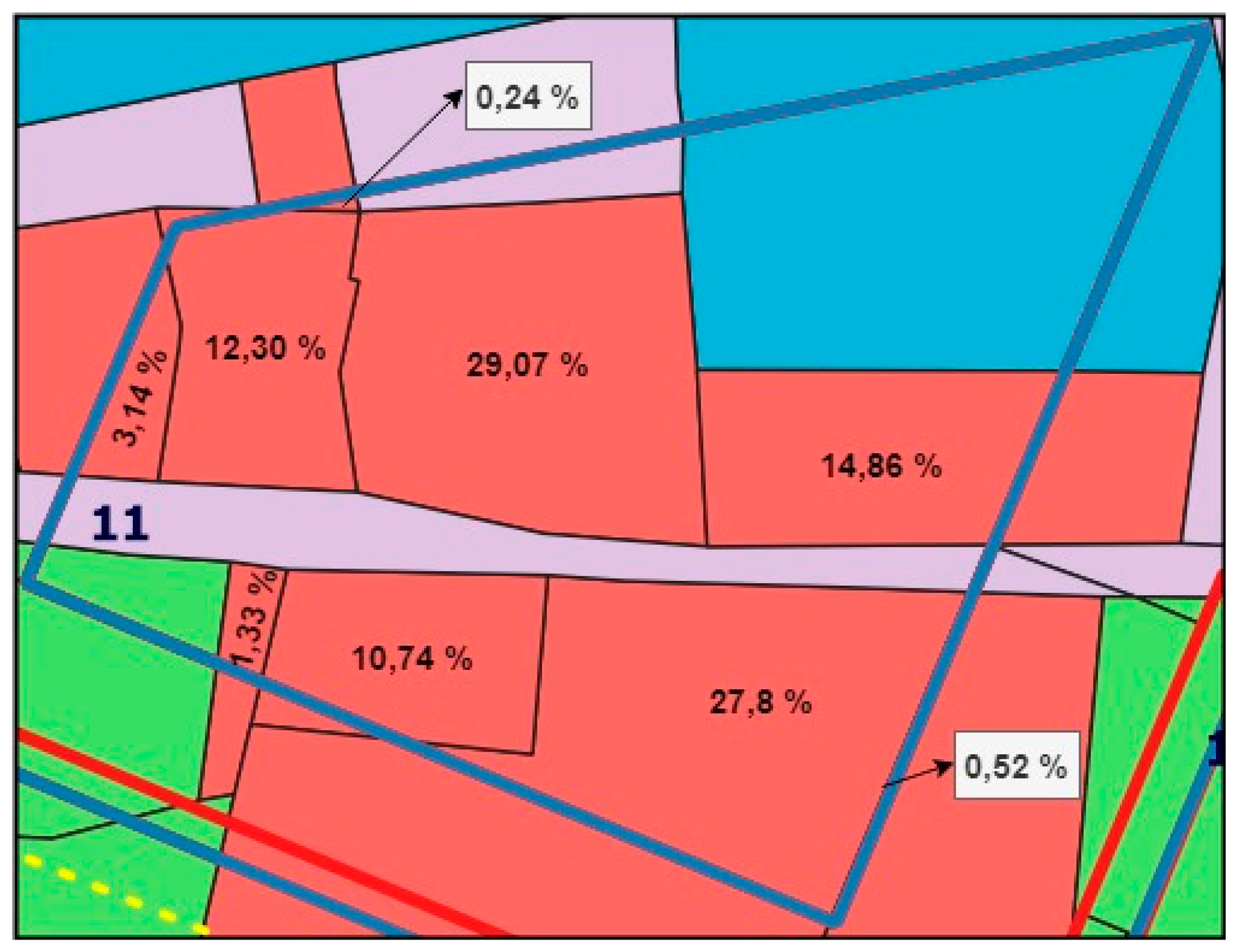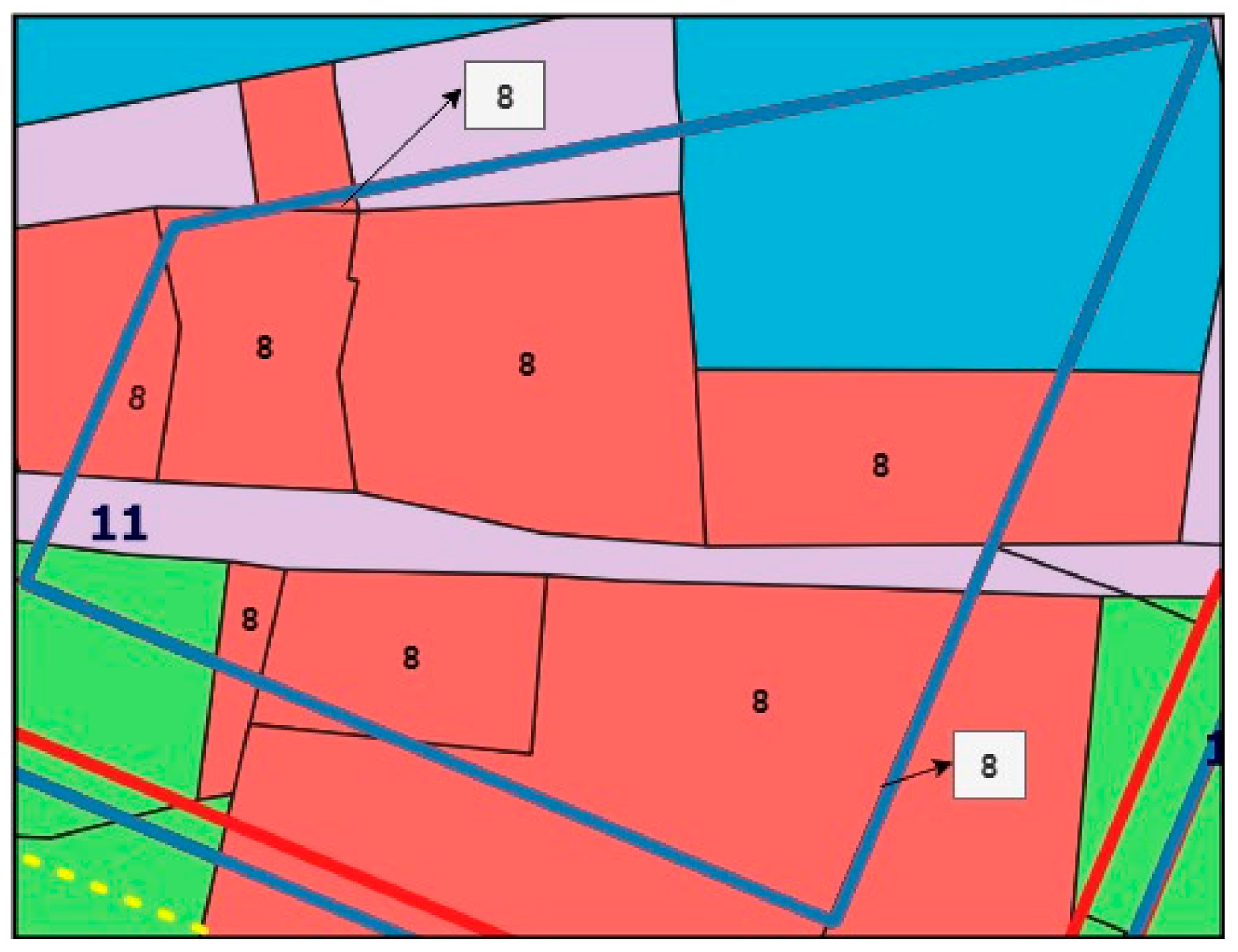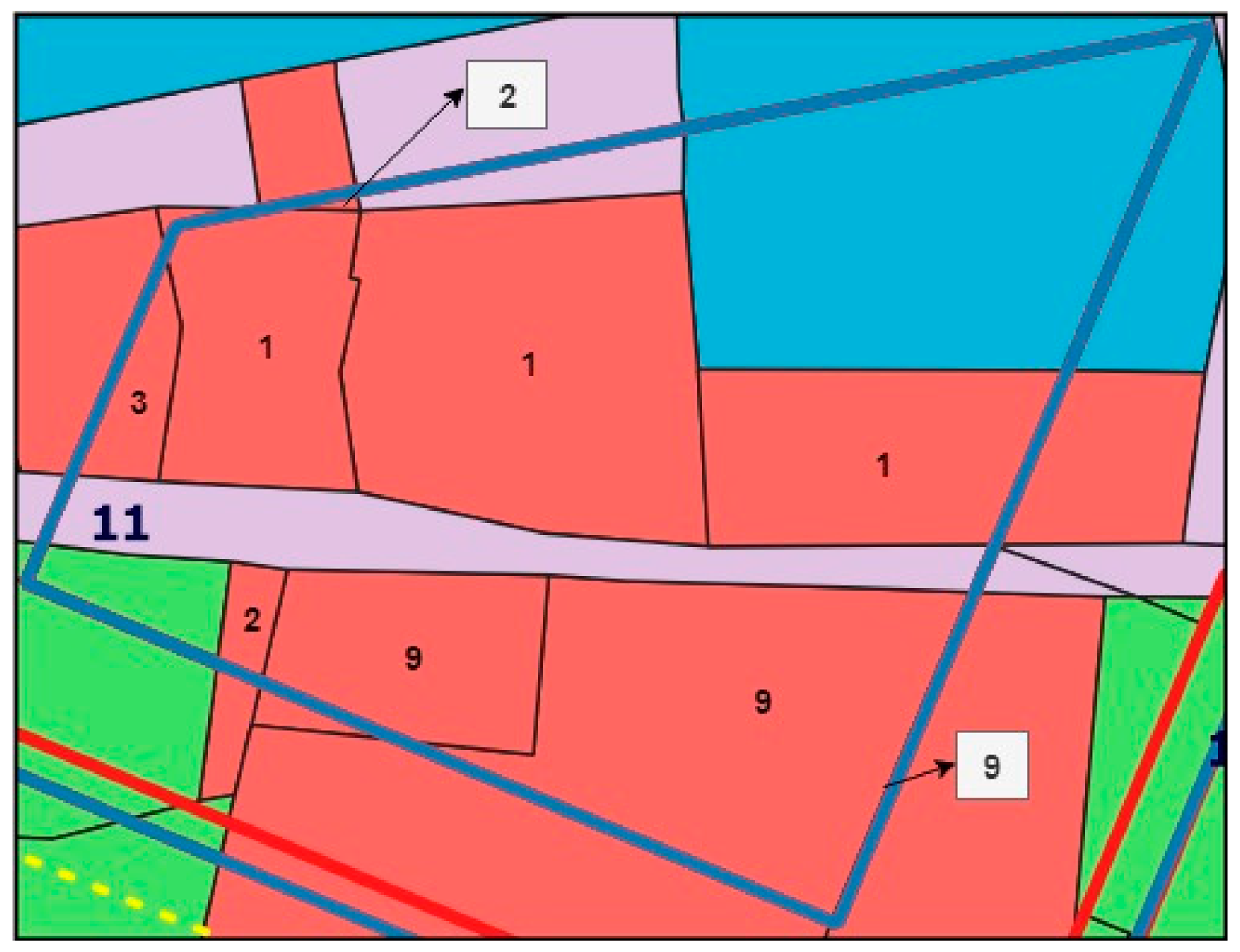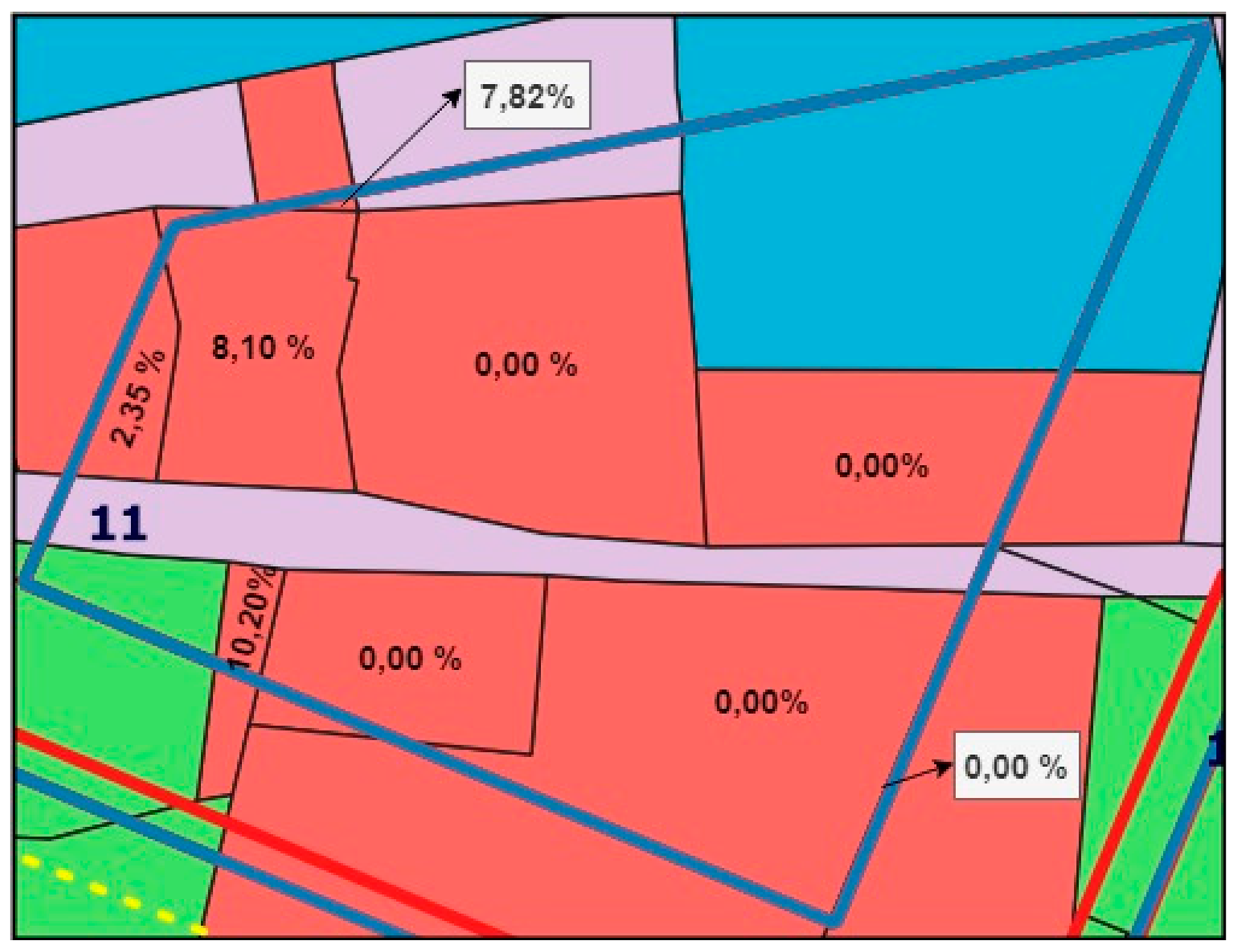3.2. Index of Fragmentation Assessment
After the identification of the spatial elements and their logical units, all private cadastral parcels in the campus area were identified and a set of 62 parcels was established based on which validation of the index of fragmentation model was performed. By analyzing the cadastral parcels attributes, a basis for defining the ideal parcel and evaluation criteria for determining the index of fragmentation was established. Four criteria were identified for Parcel Index of Fragmentation. Two defined the relationship of a particular cadastral parcel to other cadastral parcels belonging to the same spatial element (C1 and C2), while two were related to the internal fragmentation of cadastral parcel (C3 and C4). Ownership fragmentation referred to the number of co-owners of each cadastral parcel as the total number of people to negotiate for participation in the urban renewal process. This criterion could be elaborated in more detail taking into account along with the number of owners also their ownership condition that can be defined as co-ownership, joint ownership and tenant ownership. Each of those mentioned above could be assigned a weight of importance, but given that the owners of all the cadastral parcels on the campus area are in the co-ownership, the simpler version was used. The next step was the evaluation of private cadastral parcels by each criterion. The GIS tools were used for alternatives assessment by all defined criteria. Based on these values the decision matrix was formed where each row gave an estimate of one cadastral parcel through all criteria, and each column gave an evaluation of all cadastral parcels by one criterion.
Table 6 shows part of the decision matrix with the values of evaluated cadastral parcels and its parts in the campus area. The first column shows the number of cadastral parcels or its parts, while the second column refers to the identification tag of the logical unit to which a particular cadastral parcel or its part belongs. For the sake of transparency, the decision matrix is shown for 10 of 62 cadastral parcels or its parts.
As already mentioned, the weights were defined by the Fuzzy AHP method according to the Saaty’s scale of relative importance. Five experts from the Faculty of Civil Engineering, Architecture and Geodesy, University of Split and the Faculty of Geodesy, University of Zagreb were involved in the research process.
Table 7 shows fuzzy compromise weights of five experts which are defined by Equations (4)–(6) as a geometric mean of lower, middle and upper triangular value of criteria weight.
Normalization of criteria weights was derived by Equation (7). After that geometric mean of each column was derived to obtain final lower, middle and upper weights of each criterion. In
Table 8 triangular normalized and final criteria weights are given.
The final lower and upper α values for each criterion calculated by Equation (9) are given in
Table 9.
Defuzzified weight values were obtained by combining the lower and upper α values using the optimism index and their normalized values are given in
Table 10.
In order to combine and compare the defined criteria, it was necessary to perform the normalization of the input data, i.e., to resume their values in the range from 0 to 1. Sometimes the relation between the original data and their normalized values are much more complex and cannot be described with a linear function. For this reason, the normalization of certain criteria is carried out by applying value functions that, apart from factual information, are also related to the experiential judgments of experts involved in its definition. Creating value functions is a very important and complex task because their values directly affect the accuracy of later accounting [
1]. Value functions are the result of a specially designed interview conducted between decision-makers and experts involved in the decision-making process. There are several different methods of defining value functions, and for this research the direct value rating method [
47] was chosen. Below is explained the linear normalization of the slope criteria and the normalization of the number of co-owners criterion using the value function in the form of the fourth order polynomial function.
The value of the “Slope” criterion is defined by the linear transformation of the cadastral parcels’ slope expressed in degrees in the range from 0 to 1. In accordance with the ordinance of standards for the determination of particularly valuable land for cultivation (P1) and the valuable agricultural land (P2) [
48], value 1 was assigned to those cadastral parcels having a slope from 0° to 2°, while value 0 was assigned to the cadastral parcels which have a slope of 33° and above. The linear function for slope normalization was defined by the expression (
is slope of the cadastral parcel j,
is normalized slope value of the cadastral parcel j, and
is an expression for linear function):
Figure 5 is a graphical representation of a linear function for slope criterion.
The value of the “Number of co-owners” criterion was defined by the fourth order polynomial function expressed in the range from 0 to 1. Value 1 was assigned to those cadastral parcels having only one private owner, while value 0 was assigned to the cadastral parcels which had 10 or more co-owners. The value function for the number of co-owners normalization was defined by the expression (
is number of the cadastral parcel j co-owners,
is a normalized number of co-owners values of the cadastral parcel j, and
is an expression for the fourth order polynomial function):
Figure 6 presents the number of a co-owners value function.
Table 11 presents the normalized values of the cadastral parcels evaluated by the defined criteria and the normalized values of their defuzzified weights. By using the SAW method, the final values of the index of fragmentation are given for all 62 cadastral parcels as well as for its parts. The final result of each alternative was obtained as a sum of the product of the normalized criteria values and normalized values of criteria weights:
For the sake of transparency, the decision matrix is shown for 10 of 62 cadastral parcels or its parts.
Since the priority ranking of the private cadastral parcels in the urban renewal planning process was implemented for whole cadastral parcels their final values were, in respect to the expert decision, determined by arithmetic mean:
Table 12 shows the final index of fragmentation values for 62 cadastral parcels. The index of fragmentation values of the private cadastral parcels at the campus area ranged from IF (6535/3) = 0.1078 as a minimum value (indicating the most fragmented cadastral parcel) to IF (6528/6) = 0.9011 as a maximum value (indicating the least fragmented cadastral parcel). More than half, precisely 49 out of 62 cadastral parcels had index of fragmentation (IF) values less than 0.5. That made up 79% of the total number of cadastral parcels, so it can be considered that the campus area is an extremely fragmented area for the purpose of urban renewal. The obtained index of fragmentation values were used in the later calculation for the final ranking of the private cadastral parcels in the process of urban renewal planning.
Figure 7 shows the distribution of private cadastral parcels along with their index of fragmentation in the campus area. Light green tones show private cadastral parcels with a higher degrees of fragmentation, while dark green tones depict private cadastral parcels that are best rated by defined criteria (with the smallest degrees of fragmentation).
Parcel Index of Fragmentation was one of the elements to define an index of fragmentation of basic spatial elements (spatial units, elements of road infrastructure and elements of green areas) which refer to the second level planning of the future project construction realization.
Road Infrastructure Index of Fragmentation was determined by two criteria, and its final estimate is obtained by the arithmetic mean:
After calculating the Parcel Index of Fragmentation, the Road Infrastructure Index of Fragmentation, Spatial Unit Index of Fragmentation and Green Area Index of Fragmentation can now be calculated on the second level of planning the large public project.
Table 13 presents the Road Infrastructure Index of Fragmentation values for 28 elements of road infrastructure which contained private cadastral parcels or its parts. The index of fragmentation values of road infrastructure elements at the campus area range from IF (PA15) = 0.2289 as a minimum value (indicating the most fragmented element of road infrastructure) to IF (OP8) = 0.9213 as a maximum value (indicating the least fragmented element of road infrastructure). Most of the elements, precisely 18 of 28 had index of fragmentation values greater than 0.5. That made up 64% of the total number of elements, so it can be concluded that road infrastructure elements do not show a high level of fragmentation for the project realization planning.
Similarly to Road Infrastructure Index of Fragmentation, Green Area Index of Fragmentation is determined by two criteria, and its final estimate is obtained by the arithmetic mean.
Table 14 presents Green Area Index of Fragmentation for three elements. Two of three IFGA have relatively high values which means that green areas show a low level of fragmentation for the project realization planning.
As before mentioned, Spatial Unit Index of Fragmentation was defined with four criteria and its final assessment was obtained by the arithmetic mean:
In
Table 15 the final values of Spatial Unit Index of Fragmentation are given. The table shows IFSU for 11 future objects in the campus area. Considering that a total number of objects in the campus was 19, it can be concluded that most of the areas of future object construction have a problem with ownership issues. The table presents the Spatial Unit Index of Fragmentation for 11 future objects. The index of fragmentation values ranged from IF (SU19) = 0.2663 to IF (SU6) = 0.9079 and the vast majority, nine of eleven, have the very high index of fragmentation values. This result, similarly to IFRA and IFGA does not show a high level of fragmentation for the project realization planning.
For the first level of planning in order to select the most favorable location for the future project construction, the criteria for comparing the alternative solutions were numerically defined and given in
Table 16. As is stated above, for this level of planning the identified criteria are just numerically defined while their total assessment, i.e., the index of fragmentation for location selection, can be obtained when compared with other potential alternative solutions. Since the location of the campus project is already known in advance, and to truly use a realistic example for validation of this model, the possibility and the need to use the index of fragmentation as a spatial functional criterion was identified in selecting the most favorable location for the construction of the future project. For comparison, criteria values should be normalized using linear standardization or specially designed value functions based on the opinion of the experts involved in the decision-making process.
The results obtained show applicability in the context of decision-making in the process of planning a large public project. As one of the criteria in the goal tree to support the realization of a large public project, they cover an important spatial–functional segment that quantifies the condition of an existing situation in the context of use for the construction of future spatial elements. In this case, the priority rank of the spatial elements was defined by the assessment of the index of fragmentation. The realization of a large public project, such as a campus of the University of Split, involves several project phases of realization, from selecting the location of a future project, making a plan of project realization and making a plan for implementing urban renewal as a specific urban land consolidation process. For each of the above-mentioned phases, spatial functionality of the study areas, i.e., spatial elements defined by the urban plan is analyzed and it is expressed through their deviation from the ideal area of construction, the ideal spatial element and the ideal cadastral parcel. It is important to emphasize that the index of fragmentation supports the project planning process, but when elaborating the final plan it is necessary also to analyze in detail all the technical, social, economic, ecological and other spatial–functional effects on the future project implementation, the overall impact of which will give insight in order to support the decision-making of the stakeholders involved in the planning process.
